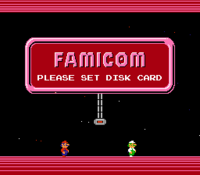Family Computer Disk System: Difference between revisions
No edit summary |
m (Robot: Automated text replacement (-[[Mario (series) +[[Mario (franchise))) |
||
| Line 20: | Line 20: | ||
==Games== | ==Games== | ||
[[File:Famicom_Zelda_Disk.png|right|200px|thumb|Disk of ''The Hyrule Fantasy: Zelda no Densetsu''.]] | [[File:Famicom_Zelda_Disk.png|right|200px|thumb|Disk of ''The Hyrule Fantasy: Zelda no Densetsu''.]] | ||
Here's the list of [[Mario ( | Here's the list of [[Mario (franchise)|''Mario'']] or related games released for the Disk System: | ||
*''[[All Night Nippon Super Mario Bros.]]'' | *''[[All Night Nippon Super Mario Bros.]]'' | ||
*''[[Famicom Grand Prix: F-1 Race]]'' | *''[[Famicom Grand Prix: F-1 Race]]'' | ||
Revision as of 22:00, August 1, 2016
The Family Computer Disk System (also called the Famicom Disk System) is an accessory for the Family Computer. It allowed the Family Computer to play certain games on a floppy disk rather than a cartridge. Floppy disks had the advantages of being cheaper. Besides that, the disks were rewritable, making saving easier. Sharp Corporation, a Japanese Electronics and Domestic Appliance company, created the Twin Famicom, a Family Computer combined with the Disk System into one piece of hardware, but it was also only released in Japan.
The main reason why Famicom Disk System was not released outside Japan is believed to be due to a lack of success caused by various issues with the system:[1]
- The games were easier to pirate, due to the low amount of copy protection (i.e. recognizing legitimate disks by an empty space on the bottom).
- The games were easier to damage, as floppy disks were sensitive to magnetic wavelengths and exposed the strip that lets the system recognize and run the game. In the latter case, the strip could get scratched, dirty, or even grow mold in severe cases.
- Because of the enhanced sound qualities, audio was hard to convert when the games were ported to cartridges.
- The games had lengthy loading times at various points (often when swapping sides, or when entering an area that cannot be processed easily).
- Most games required the player to eject the disk at various points, flip them over, and re-insert them (often after the title screen and on the game's final stretch), similarly to how various PlayStation games require the player to eject and swap optical disks at certain points.
- The jewel cases that contained the games were smaller than cartridge boxes, and were therefore easier to overlook in stores or lose in homes. The cases were also required to fully protect the disk, whereas cartridges could be stored, standalone, on shelves.
Games
Here's the list of Mario or related games released for the Disk System:
- All Night Nippon Super Mario Bros.
- Famicom Grand Prix: F-1 Race
- Famicom Grand Prix II: 3D Hot Rally
- Golf: Japan Course
- Golf: Japan Course (Gold)
- Golf: US Course
- Golf: US Course (Gold)
- I Am a Teacher: Super Mario Sweater
- Kaettekita Mario Bros.
- Super Mario Bros.: The Lost Levels
- Yume Kōjō: Doki Doki Panic
Names in other languages
Trivia
- Mario and Luigi also appear in the Disk System's BIOS, seen when the Disk System is started. The BIOS also makes a cameo appearance in Paper Mario: The Thousand-Year Door, on Sir Grodus's computer. His computer accepts Data Disks that looks like a Disk System disk.[2]
- When sped up about 16 times, the GameCube menu ambience is revealed to be a slowed-down version of the startup tune for the Disk System BIOS. [3]

